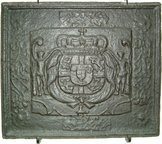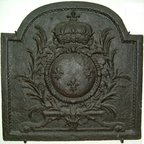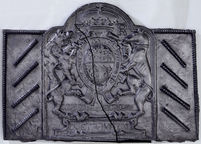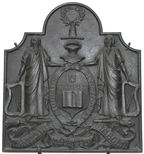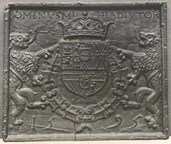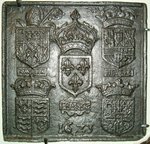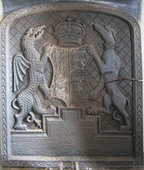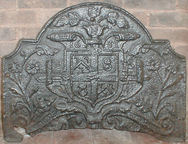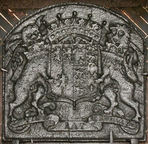-
764
Description: Stove-plate; rectangular; flanged edging; central rectangular panel bearing the shield of the kingdom of Denmark and Norway with male supporters, encircled by the chain of the Order of the Elephant; one each side of the central panel, repeated floriate stamps and flower heads.
Notes: A similar plate is illustrated by Nygard-Nilssen vol. 1, p.255. The poor detail suggests that this is a copy.
Arms: Kingdom of Denmark and Norway
- Decoration tags:
- rectangular (shape)
- flanged (edging)
- carved stamps
- carved pattern panels
- armorial
Manufactured: in the early- to mid-18th century .
Current location: Victoria & Albert Museum, Cromwell Road, Kensington & Chelsea, Greater London, England.
Museum number: M.12-2002 (part of the Victoria & Albert Museum museum group)
Citation: Nygard-Nilssen, A., 1944, Norsk Jernskulptur (Oslo, Cappelens Forlag).
- Attached to series:
- Foreign armorial firebacks
-
765
Description: Arched rectangular; fillet edging with darts on the inside; circular arms of France within the chains of the Ordre d'Esprit and the Ordre de St Michel, with crown above, all resting on a framework compartment, with olive leaf sprays on each side ofn the shield.
Notes: Typical form of the arms of France of the period of Louis XIV.
Arms: France modern
- Decoration tags:
- rectangular with round arch (shape)
- fillet (edging)
- whole carved pattern
- armorial
- royal
Manufactured: in the late-17th to early-18th century in France.
Current location: Victoria & Albert Museum, Cromwell Road, Kensington & Chelsea, Greater London, England.
Museum number: M.1132-1926 (part of the Victoria & Albert Museum museum group)
Citation: Carpentier, H., 1912, Plaques de Cheminées (Paris, published by the author).
- Attached to series:
- Foreign armorial firebacks
-
766
Description: Canted rectangle; ovolo-moulded edging; shield and dolphin crown of the dauphin of France, encircled by the Ordre d'Esprit and the Ordre de St Michel; dolphins in the bottom corners, separating digits of the date.
Notes: The 24th Dauphin was Louis, son of Louis XV and father of Louis XVI. Part of the bequest to the Victoria and Albert Museum by Lieut. Colonel G. B. Croft-Lyons in 1926.
Inscription: 1 7 5 0
Arms: Dauphin of France (24th Dauphin)
- Decoration tags:
- rectangular with canted top corners (shape)
- ovolo (edging)
- whole carved pattern
- armorial
- royal
Manufactured: in 1750 in France.
Current location: Victoria & Albert Museum, Cromwell Road, Kensington & Chelsea, Greater London, England.
Museum number: M.625-1926 (part of the Victoria & Albert Museum museum group)
- Attached to series:
- Foreign armorial firebacks
-
768
Description: Arched rectangular shape with rounded corners; ovolo within fillet moulding all round; oval Tudor royal shield with garter surrounding, topped with a royal crown; dragon and greyhound supporters; initials split by crown; inscription on a fillet between legs of supporters, behind garter finial; motto on an Ionic plinth at bottom; two rectangular side panels with twisted rope edging top and side; a short length of turned dowel stamped four times, diagonally, on each panel.
Notes: The supporters are those of Henry VII or Henry VIII, but the initials suggest the fireback dates from the reign of Edward VI (1547-53). John Harvo (d. c1565) was a gunfounder who has been identified as occupying Pounsley furnace, Framfield, Sussex, possibly from as early as 1547; the fireback may have been cast originally during the reign of Henry VIII (1509-47), with the initials added to an early casting using the original pattern. The disparity between the worn surface of the armorial panel and the greater clarity of the extensions indicates that the extended casting was made using an already well-used armorial fireback and therefore at a substantially later date.
Copies of this fireback are known.
Inscription: E R / HONY SOIT QVE MAL Y PAYNCE / Made in Sussex by John Harvo / DV ET MOVN DROI
Arms: Tudor royal - Probably Henry VIII
- Decoration tags:
- rectangular with round arch (shape)
- rope (edging)
- carved stamps
- whole carved pattern
- individual letters
- extension panels
- armorial
- royal
- text
- objects
Manufactured: in the late-16th century in England.
Current location: Victoria & Albert Museum, Cromwell Road, Kensington & Chelsea, Greater London, England.
Museum number: 685.1899 (part of the Victoria & Albert Museum museum group)
- Attached to series:
- Pounsley series
- John Harvo series
-
772
Description: Cavetto canted arched rectangle; astragal edging; oval inscription surrounding a central battlemented shield bearing an open book, with a baronet's escutcheon above; above, a helm with a crest of an arm and hand holding a wreath; on each side, a druid supporter holding a harp, each upon a horizontal fillet; below, intertwined bell flowers behind a tripartite motto scroll.
Notes: The motto appears to have been incorrectly spelled; the Conroy baronetcy was created for Sir John Conroy, comptroller of the household of the Duchess of Kent, and much hated by her daughter, Princess (later Queen) Victoria; the 3rd (and last) baronet succeeded to the title in 1869.
Inscription: FIDELITER ET CONSTANTER [Faithfully and constantly] / L'ANTIQIVITE NE PEVX PAS L'ABOLIR [Antiquity cannot abolish it]
Arms: Conroy, baronet, of Llanbrynmair (Sir John Conroy, 3rd baronet, 1845-1900)
- Decoration tags:
- rectangular with canted top corners and round arch (shape)
- astragal (edging)
- whole carved pattern
- armorial
- text
- humans
Manufactured: in the late-19th century in England.
Current location: Victoria & Albert Museum, Cromwell Road, Kensington & Chelsea, Greater London, England.
Museum number: 502.1896 (part of the Victoria & Albert Museum museum group)
- Attached to series:
- Personal armorial firebacks
- Welsh armorial firebacks
-
1227
Description: Rectangular shape with ovolo-moulded edging; within the collar of the Order of the Golden Fleece, a central shield of the arms of Spain: quarterly Castile and Leon, Aragon and Aragon-Sicily, with an escutcheon of Portugal; in base Austria, Burgundy ancient, Burgundy modern and Brabant with an escutcheon of Flanders impaling Tyrol; above, a crown; supporters: two golden lions rampant; below the shield, the date, 1595; above the crown, the inscription: Dominus mihi adiutor (the Lord is my helper).
Notes: The arms of King Philip II of Spain following the unification with Portugal, as used in the Spanish Netherlands. Part of the bequest to the Victoria and Albert Museum by Lieut. Colonel G. B. Croft-Lyons in 1926.
Copies of this fireback are known.
Inscription: DOMINVS MIHI ADIVTOR
Arms: King Philip II of Spain (Spanish Netherlands)
- Decoration tags:
- rectangular (shape)
- ovolo (edging)
- whole carved pattern
- heraldic
- armorial
- royal
- text
- animals
Manufactured: in 1595 possibly in the Ardennes area of Belgium.
Current location: Science Museum, Exhibition Road, Kensington & Chelsea, London, England.
Museum number: M.624.1926 (part of the Victoria & Albert Museum museum group)
- Attached to series:
- Foreign armorial firebacks
-
1171
Description: Rectangular shape; fillet edging; arrangement of five shields: centre, arms of the kingdom of France surmounted by a crown and, below, the word FRANCE on a fillet edged rectangular block over a cartouche; top left, arms of the duchy of Lorraine surmounted by a bishop's mitre and crozier separating a largely illegible text; top right, arms of the kingdom of Spain surmounted by a crown with the letters SPA to the left; bottom right, arms of the duchy of Nevers surmounted by a coronet below a fillet edged rectangle with the word NEVERS; bottom left, arms of the kingdom of England surmounted by a crown below a fillet edged rectangle with the word ANGLIA; bottom centre, the date 1623.
Notes: A taque de foyer or takenplatte; the arms in the corners are likely to be of (from top left): Louis III of Lorraine, Archbishop of Reims; King Philip III of Spain; Charles I, Duke of Nevers and Rethel; and Queen Elizabeth I of England. A similar fireback with the same arms, illustrated by von den Driesch (1990, p.181), has the date 1611, but the absence of a cardinal's hat over the arms of Louis of Lorraine suggests that the fireback originally dates from before 1605.
Inscription: [LORR]AI[NE] SPA / ANGLIA NEVERS / FRANCE / 16z3
Arms: Louis of Lorraine; Kingdom of Spain; Kingdom of France; Kingdom of England; Charles Gonzaga, Duke of Nevers
- Decoration tags:
- rectangular (shape)
- fillet (edging)
- whole carved pattern
- individual numbers
- heraldic
- armorial
- royal
- text
Manufactured: in 1623 possibly in the Ardennes area of Belgium.
Current location: Musée Gaumais, 38 Rue d'Arlon, Virton, Luxembourg, Belgium.
(part of the Musée Gaumais, Virton museum group)
- Attached to series:
- Foreign armorial firebacks
-
1246
Description: Low-arched shape within broad fillet edging marked with a repeated leaf pattern ascending toward the top; on an incised criss-cross field a Tudor royal shield, quarterly France Modern and England, supported by a stylised, scaly dragon and greyhound and surmounted by a crown, all resting on a two-stepped compartment with cavetto- and astragal-moulded edging at the top.
Notes: Pastiche 'Tudor' design by George Shaw of Saddleworth, Lancashire, c.1850, possibly intended to be passed off as genuine Tudor. Another casting in this form is in Cheetham's Library, Manchester. A variant exists without the leaf pattern on the edging and the 'scales' on the dragon. Firebacks of the same armorial design within a different, arched rectangular, edging are also known.
Copies of this fireback are known.
Arms: Tudor royal
- Decoration tags:
- rounded arched (shape)
- custom with repeated leaf pattern (edging)
- whole carved pattern
- heraldic
- armorial
- royal
Manufactured: in the mid-19th century possibly in the Lancashire area of England.
Current location: Warkworth Castle, Warkworth, Northumberland, England.
(part of the English Heritage museum group)
- Attached to series:
- Tudor royal armorial firebacks
- George Shaw series
-
43
Description: Arched rectangular shape with ovolo canted top corners; fillet edging; within a cartouche, shield of the Worshipful Company of Barber-Surgeons - quarterly, first and fourth, Sable a Chevron between three Fleams Argent, second and third, Per pale of the second and Vert on a Spatter also Argent a Tudor Rose proper crowned Or; on a Cross Gules dividing the quarters a Lion passant guardant Or; the date is above the shield, which is surmounted by a vase from which are displayed a flower and leaf stems; the same occupy the spaces on each side of the shield, below which is a motto scroll.
Notes: The arms on this fireback were granted to the company in 1569.
Copies of this fireback are known.
Inscription: 1631
Arms: Worshipful Company of Barber-Surgeons
- Decoration tags:
- rectangular with canted top corners and round arch (shape)
- fillet (edging)
- whole carved pattern
- heraldic
- armorial
- text
Manufactured: in 1631 possibly in the Weald area of England.
Current location: not known.
- Attached to series:
- Livery company firebacks
-
873
Description: Arched shape; fillet edging; shield, supporters, earl's coronet and motto.
Notes: The arms are those of William Herbert (1626-96), created 1st Earl of Powis in 1674, impaled with those of his wife, Lady Elizabeth Somerset, whom he had married in 1654. He was created Marquess in 1687, so the fireback dates from between 1674 and 1687. The blazon: Party per pale azure and gules three lions rampant argent armed and langued or (Herbert), quarterly 1st and 4th England 2nd and 3rd France Modern (Somerset); Supporters: Dexter: A Panther rampant guardant Argent spotted of various colours fire issuing out of the mouth and ears ducally gorged Azure; Sinister: A Lion rampant Argent ducally gorged Gules; Motto: Ung je serviray (One I will serve).
Inscription: Ung iay serviray
Arms: William Herbert, 1st Earl of Powis
- Decoration tags:
- rounded arched (shape)
- fillet (edging)
- whole carved pattern
- armorial
- text
Manufactured: in the late-17th century .
Current location: Powis Castle, Welshpool, Powys, Wales.
Museum number: 1180869 (part of the National Trust museum group)
Citation: Anon., 1907, 'Armorial iron fire back', Montgomeryshire Collections, 34, p. 212.
- Attached to series:
- Personal armorial firebacks
- Welsh armorial firebacks
